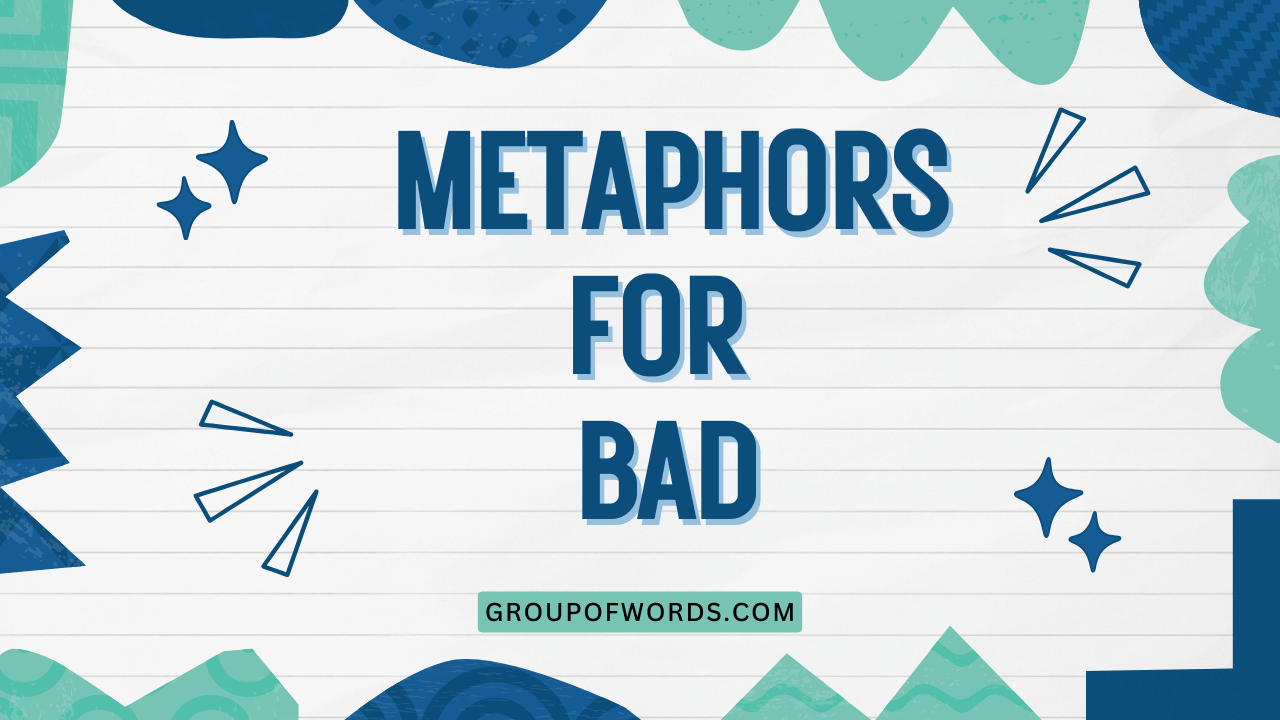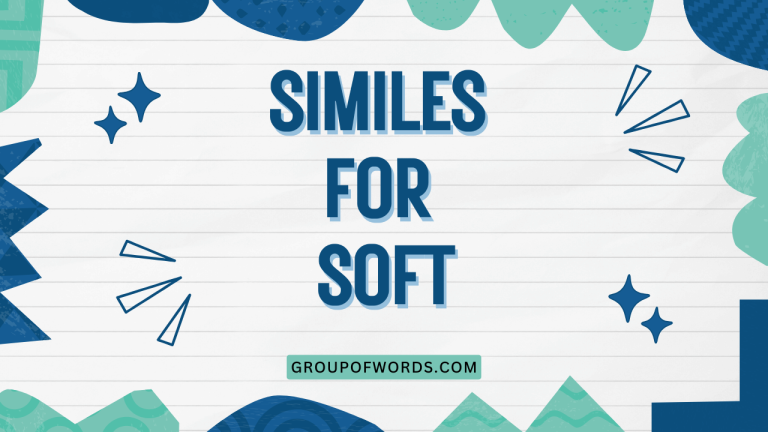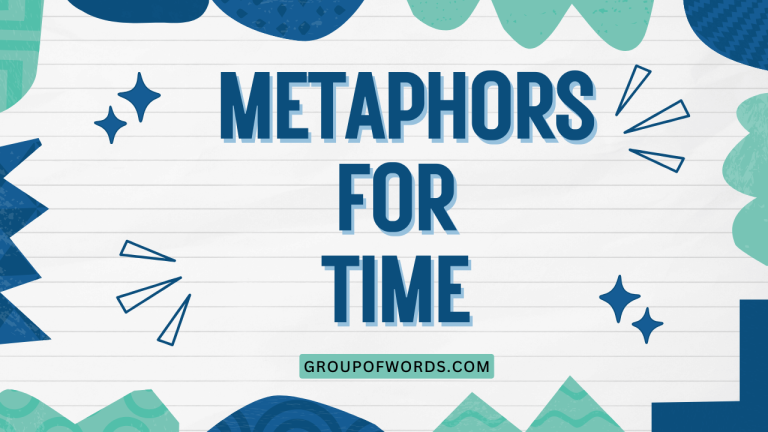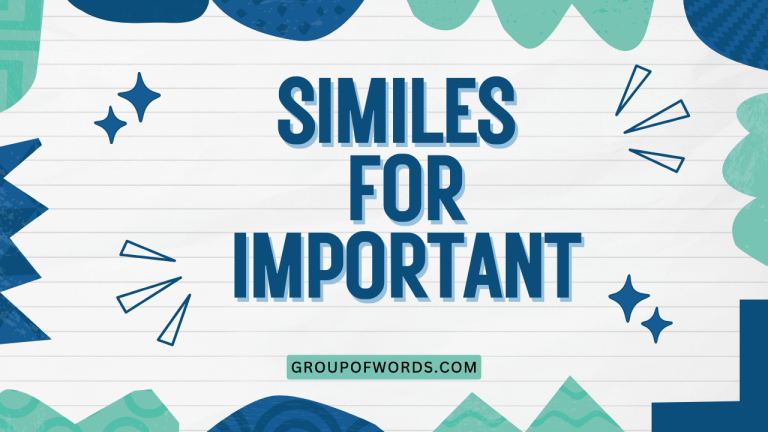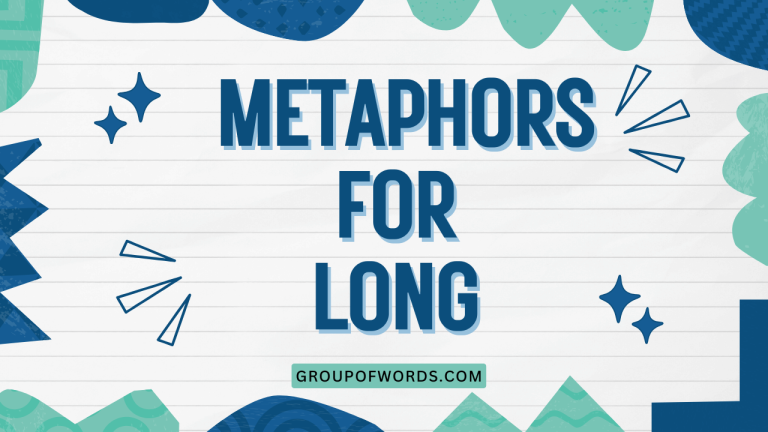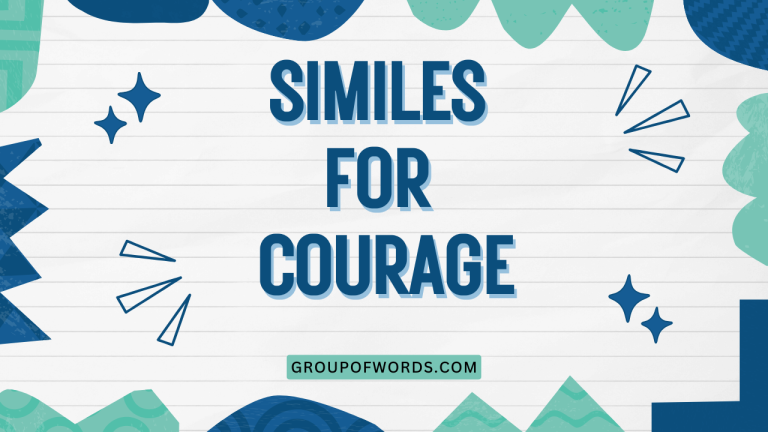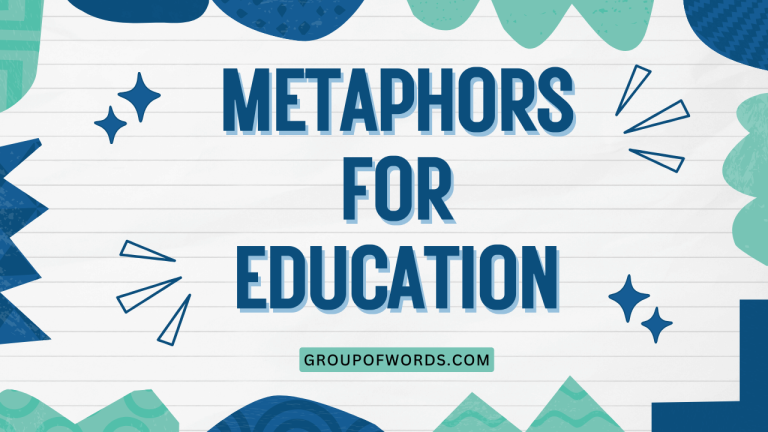Metaphors for Bad: Expressing Negativity in English
Metaphors are powerful tools in the English language, allowing us to express abstract concepts in vivid and relatable ways. When it comes to describing something “bad,” metaphors provide a rich tapestry of expressions beyond simple adjectives.
Understanding these metaphors enhances your vocabulary, improves comprehension, and makes your communication more engaging. This article explores a wide range of metaphors for “bad,” categorizing them and providing examples to help you master their usage.
This guide is perfect for English language learners, writers, and anyone looking to add nuance and creativity to their language.
This article will delve into the various types of metaphors used to describe negative situations, qualities, and experiences. We will explore metaphors related to decay, darkness, illness, obstruction, and more, providing extensive examples and usage guidelines.
By the end of this article, you’ll be equipped to recognize, understand, and effectively use metaphors for “bad” in your own writing and speech.
Table of Contents
- Introduction
- Definition of Metaphor for “Bad”
- Structural Breakdown of Metaphors
- Types of Metaphors for “Bad”
- Examples of Metaphors for “Bad”
- Usage Rules for Metaphors
- Common Mistakes with Metaphors
- Practice Exercises
- Advanced Topics in Metaphorical Usage
- Frequently Asked Questions
- Conclusion
Definition of Metaphor for “Bad”
A metaphor is a figure of speech that directly compares two unrelated things, suggesting a similarity between them. Unlike similes, which use “like” or “as” to make a comparison, metaphors state that one thing is another. Metaphors for “bad” use something inherently negative or undesirable to describe a situation, object, person, or idea that is considered unfavorable, harmful, or deficient. These metaphors function by transferring the negative qualities of the source domain (e.g., decay, darkness) to the target domain (the thing being described as “bad”).
In essence, metaphors for “bad” allow us to express the severity, nature, and impact of negativity in a more evocative and nuanced way than simply using adjectives like “bad,” “terrible,” or “awful.” The function of these metaphors is to create a deeper understanding and emotional connection with the listener or reader, making the negative aspect more palpable and memorable. The context in which these metaphors are used is crucial, as the effectiveness of a metaphor depends on its appropriateness and relevance to the situation.
Structural Breakdown of Metaphors
Understanding the structure of a metaphor helps in both interpreting and creating them effectively. A metaphor consists of two main elements: the tenor and the vehicle. The tenor is the subject to which metaphorical attributes are ascribed, and the vehicle is the object whose attributes are borrowed. In the case of metaphors for “bad,” the tenor is the thing being described as negative, and the vehicle is the element that embodies the negative quality.
For example, in the metaphor “a rotten idea,” the tenor is the “idea,” and the vehicle is “rotten.” The negative connotations of “rotten” (decay, unpleasantness, uselessness) are transferred to the idea, suggesting it is flawed and undesirable. The effectiveness of a metaphor also relies on the implied comparison, which is the shared characteristic between the tenor and the vehicle.
In this case, the shared characteristic is the quality of being undesirable or unfit for purpose.
The following table illustrates the structural breakdown of a few examples:
| Metaphor | Tenor (Subject) | Vehicle (Object) | Implied Comparison |
|---|---|---|---|
| A dark secret | Secret | Dark | Hidden, unpleasant, potentially harmful |
| A thorny issue | Issue | Thorny | Difficult to handle, causing pain or discomfort |
| A crumbling economy | Economy | Crumbling | Weakening, falling apart, unstable |
Types of Metaphors for “Bad”
Metaphors for “bad” can be categorized based on the specific negative concept they evoke. Here are some common types:
Metaphors of Decay
These metaphors use the imagery of rotting, decomposition, and deterioration to describe something that is declining in quality, value, or strength. They often imply a sense of corruption or moral degradation.
Examples include “rotten,” “decaying,” “moldy,” and “corrupt.”
Metaphors of Darkness
Darkness is often associated with evil, ignorance, or the unknown. Metaphors of darkness describe something as hidden, sinister, or lacking in clarity.
Common examples include “dark,” “shadowy,” “bleak,” and “murky.”
Metaphors of Illness
These metaphors draw parallels between a negative situation and a disease or ailment. They suggest that something is unhealthy, harmful, or spreading negativity.
Examples include “toxic,” “sick,” “infected,” and “cancerous.”
Metaphors of Obstruction
Obstruction metaphors describe something that hinders progress, creates difficulties, or prevents success. They often involve images of barriers, blockages, or entanglement.
Examples include “thorny,” “rocky,” “rough,” and “entangled.”
Metaphors of Burden
These metaphors convey a sense of weight, pressure, or oppression. They suggest that something is difficult to bear, causing stress or hardship.
Examples include “heavy,” “burdened,” “oppressive,” and “crushing.”
Metaphors of Sharpness
Sharpness metaphors describe something that is painful, critical, or dangerous. They evoke images of cutting, piercing, or stinging.
Examples include “bitter,” “sharp,” “cutting,” and “stinging.”
Metaphors of Dirt
Dirt metaphors associate something with impurity, contamination, or moral uncleanliness. They often suggest that something is tainted or corrupted.
Examples include “dirty,” “filthy,” “tainted,” and “soiled.”
Metaphors of Instability
Instability metaphors describe something that is unsteady, unreliable, or prone to failure. They evoke images of shaking, collapsing, or teetering.
Examples include “shaky,” “fragile,” “unstable,” and “crumbling.”
Examples of Metaphors for “Bad”
Here are several examples of metaphors for “bad,” categorized by type, to illustrate their usage and effectiveness.
Table 1: Metaphors of Decay
This table provides examples of how metaphors of decay are used to describe negative situations, objects, or people.
| Metaphor | Example Sentence |
|---|---|
| Rotten apple | He’s the rotten apple in the organization, corrupting everyone around him. |
| Decaying infrastructure | The city’s decaying infrastructure is a major concern for public safety. |
| Moldy reputation | The scandal left his reputation with a moldy stain that was hard to remove. |
| Corrupt system | The country’s corrupt system breeds inequality and injustice. |
| Wilted dreams | Her wilted dreams were a testament to the hardships she had faced. |
| Spoiled goods | The spoiled goods represent the failed policies of the government. |
| Rancid relationship | Their rancid relationship was filled with bitterness and resentment. |
| Festering wound | The unresolved conflict became a festering wound in the community. |
| Putrid smell | The putrid smell of corruption permeated the entire institution. |
| Decomposing ethics | The company’s decomposing ethics led to its downfall. |
| Rotting foundations | The rotting foundations of the building made it unsafe to inhabit. |
| Decayed values | Society’s decayed values are a cause for concern among many. |
| Moldering documents | The moldering documents revealed a history of deceit and betrayal. |
| Corrupted data | The corrupted data led to inaccurate analysis and flawed decisions. |
| Wilted hopes | Their wilted hopes were a reflection of the dire economic situation. |
| Spoiled intentions | His spoiled intentions led to unintended negative consequences. |
| Rancid feelings | Her rancid feelings towards her ex-partner lingered for years. |
| Festering resentment | The festering resentment between the two families threatened to erupt into violence. |
| Putrid politics | The putrid politics of the region made it difficult to achieve any real progress. |
| Decomposing ideals | The decomposing ideals of the revolution left many disillusioned. |
| Rotting morals | The rotting morals of the elite threatened the entire nation. |
| Decayed trust | The decayed trust between the government and the people was palpable. |
Table 2: Metaphors of Darkness
This table provides examples of how metaphors of darkness are used to describe negative situations, objects, or people.
| Metaphor | Example Sentence |
|---|---|
| Dark secret | He kept a dark secret from his family for many years. |
| Shadowy figure | A shadowy figure was seen lurking near the crime scene. |
| Bleak outlook | The economic forecast presents a bleak outlook for the coming year. |
| Murky waters | The investigation delved into the murky waters of political corruption. |
| Obscure motives | Her obscure motives made it difficult to trust her intentions. |
| Black market | The black market thrived in the city’s underbelly. |
| Dim prospects | His dim prospects for recovery were a source of great sadness. |
| Shady dealings | The company was involved in shady dealings with offshore accounts. |
| Ominous silence | An ominous silence fell over the crowd as the verdict was read. |
| Dusk of his career | He was in the dusk of his career, looking back on his accomplishments. |
| Dark past | She tried to escape her dark past by moving to a new city. |
| Shadowy presence | A shadowy presence seemed to follow her wherever she went. |
| Bleak future | The refugees faced a bleak future with little hope of returning home. |
| Murky truth | The murky truth behind the incident remained elusive. |
| Obscure origins | The artifact’s obscure origins added to its mystique. |
| Black day | The day the factory closed was a black day for the town. |
| Dim hopes | Their dim hopes were all but extinguished by the devastating news. |
| Shady character | He was known as a shady character with a questionable reputation. |
| Ominous sign | The sudden storm was an ominous sign of what was to come. |
| Dusk of civilization | Some historians believe we are living in the dusk of civilization. |
| Dark intentions | His dark intentions were hidden behind a charming smile. |
| Shadowy empire | The drug lord built a shadowy empire based on fear and violence. |
Table 3: Metaphors of Illness
This table provides examples of how metaphors of illness are used to describe negative situations, objects, or people.
| Metaphor | Example Sentence |
|---|---|
| Toxic relationship | They were trapped in a toxic relationship that was slowly destroying them. |
| Sick society | The author depicted a sick society plagued by corruption and inequality. |
| Infected with greed | The company was infected with greed, leading to unethical practices. |
| Cancerous growth | The bureaucracy had become a cancerous growth, stifling innovation. |
| Viral misinformation | Viral misinformation spread rapidly through social media. |
| Plagued by doubt | He was plagued by doubt and uncertainty about his future. |
| Diseased mind | The killer had a diseased mind, driven by twisted fantasies. |
| Contagious negativity | Her contagious negativity brought down the entire team’s morale. |
| Ailing economy | The ailing economy struggled to recover from the recession. |
| Feverish speculation | Feverish speculation surrounded the company’s upcoming announcement. |
| Toxic environment | The toxic environment at work made it difficult to be productive. |
| Sick joke | His comment was a sick joke that offended many people. |
| Infected wounds | The infected wounds of the past continued to cause pain. |
| Cancerous ideology | The cancerous ideology spread hatred and division throughout the country. |
| Viral trend | The viral trend was criticized for promoting unrealistic beauty standards. |
| Plagued by anxiety | She was plagued by anxiety about her upcoming performance. |
| Diseased soul | He was described as having a diseased soul, devoid of empathy. |
| Contagious enthusiasm | Despite the negative news, her contagious enthusiasm kept the team motivated. |
| Ailing industry | The ailing industry was struggling to adapt to the changing market. |
| Feverish anticipation | There was feverish anticipation for the release of the new film. |
Table 4: Metaphors of Obstruction
This table provides examples of how metaphors of obstruction are used to describe negative situations, objects, or people.
| Metaphor | Example Sentence |
|---|---|
| Thorny issue | The land dispute was a thorny issue that had been unresolved for years. |
| Rocky road | Their relationship had a rocky road, filled with ups and downs. |
| Rough patch | The company was going through a rough patch due to the economic downturn. |
| Entangled mess | The legal case was an entangled mess of conflicting interests. |
| Dead end | The investigation reached a dead end with no new leads. |
| Stumbling block | Lack of funding proved to be a major stumbling block in the project. |
| Hurdle to overcome | Language barriers were a significant hurdle to overcome for the immigrants. |
| Roadblock to progress | Political infighting was a roadblock to progress in the peace negotiations. |
| Bottleneck in production | The outdated equipment created a bottleneck in production. |
| Impediment to growth | Bureaucracy was a major impediment to growth for small businesses. |
| Thorny problem | The environmental regulations created a thorny problem for the industry. |
| Rocky start | The new business got off to a rocky start due to unforeseen challenges. |
| Rough sea | Navigating the political landscape was like sailing on a rough sea. |
| Entangled web | The conspiracy was an entangled web of lies and deceit. |
| Deadlock in negotiations | The negotiations reached a deadlock with neither side willing to compromise. |
| Stumbling stone | Pride can be a stumbling stone on the path to success. |
| Hurdle to jump | Convincing the investors was a significant hurdle to jump. |
| Roadblock to peace | Extremist groups were a roadblock to peace in the region. |
| Bottleneck in the system | Inefficient processes created a bottleneck in the system. |
| Impediment to success | Lack of education can be a major impediment to success. |
Table 5: Metaphors of Burden
This table provides examples of how metaphors of burden are used to describe negative situations, objects, or people.
| Metaphor | Example Sentence |
|---|---|
| Heavy burden | The responsibility of leading the company was a heavy burden. |
| Burdened with debt | The family was burdened with debt after the medical emergency. |
| Oppressive atmosphere | The oppressive atmosphere in the office stifled creativity. |
| Crushing defeat | The team suffered a crushing defeat in the championship game. |
| Weight of the world | He carried the weight of the world on his shoulders. |
| Saddled with problems | The project was saddled with problems from the very beginning. |
| Under the yoke of oppression | The people lived under the yoke of oppression for many years. |
| Laden with guilt | She was laden with guilt over her past actions. |
| Heavy heart | He left with a heavy heart, knowing he might never return. |
| Burden of proof | The burden of proof lies with the prosecution. |
| Oppressive heat | The oppressive heat made it difficult to concentrate. |
| Crushing blow | The news of her death was a crushing blow to the community. |
| Weight of expectation | The young athlete felt the weight of expectation from his family and fans. |
| Saddled with responsibility | She was saddled with responsibility at a young age. |
| Under the yoke of poverty | Many families lived under the yoke of poverty with little hope of escape. |
| Laden with sorrow | His voice was laden with sorrow as he recounted the tragic events. |
| Heavy price | They paid a heavy price for their mistakes. |
| Burden of leadership | The burden of leadership can be overwhelming at times. |
| Oppressive silence | An oppressive silence filled the room after the argument. |
| Crushing disappointment | The cancellation of the event was a crushing disappointment to the fans. |
Usage Rules for Metaphors
Using metaphors effectively requires careful consideration of several factors:
- Clarity: The metaphor should be understandable and relevant to the audience. Avoid using obscure or overly complex metaphors that may confuse the reader or listener.
- Appropriateness: The metaphor should be appropriate for the context and tone of the communication. A lighthearted metaphor may be inappropriate for a serious or sensitive topic.
- Originality: While common metaphors can be effective, using original metaphors can make your writing or speech more engaging and memorable.
- Consistency: Avoid mixing metaphors, which can create confusion and weaken the impact of your message. For example, don’t say “The idea is a rotten apple, but it has legs.”
- Purpose: Ensure the metaphor serves a clear purpose, such as clarifying a concept, evoking emotion, or adding emphasis.
In addition, be mindful of cultural differences. A metaphor that is effective in one culture may not be understood or appreciated in another.
Consider your audience and their background when choosing metaphors.
Common Mistakes with Metaphors
Here are some common mistakes to avoid when using metaphors:
- Mixed Metaphors: Combining two or more incompatible metaphors.
- Clichéd Metaphors: Overusing common or predictable metaphors.
- Inappropriate Metaphors: Using metaphors that are not suitable for the context or audience.
- Unclear Metaphors: Using metaphors that are difficult to understand or interpret.
- Overextended Metaphors: Pushing a metaphor too far, leading to absurdity or confusion.
Here’s a table illustrating some common mistakes with metaphors:
| Incorrect Example | Corrected Example | Explanation |
|---|---|---|
| The project is a rollercoaster heading for a dead end. | The project is a rollercoaster ride. / The project is heading for a dead end. | Mixed metaphor: combining “rollercoaster” and “dead end” is illogical. |
| He’s as cool as a cucumber. | He remained calm under pressure. | Clichéd metaphor: “cool as a cucumber” is overused and lacks impact. |
| The company is a cancerous tumor that needs to be pruned. | The company’s bureaucracy is a cancerous growth. / The company needs to prune its bureaucratic processes. | Inappropriate metaphor: Combining “cancerous tumor” with “pruned” is insensitive and illogical. |
| The idea is a purple elephant dancing on the moon. | The idea is unrealistic and impractical. | Unclear metaphor: “purple elephant dancing on the moon” is too abstract and difficult to interpret. |
| The ship of state sailed through the stormy seas, but its rudder was broken, its sails were torn, and its passengers were all seasick, and the captain was knitting. | The ship of state sailed through stormy seas with difficulty. | Overextended metaphor: The initial metaphor is stretched too far, becoming absurd. |
Practice Exercises
Test your understanding of metaphors for “bad” with these exercises:
Exercise 1: Identify the Metaphor
Identify the metaphor in each sentence and explain what it means.
| Question | Answer |
|---|---|
| 1. The scandal left a stain on his reputation. | The scandal left a stain (metaphor for damage or negative impact) on his reputation, meaning it negatively affected his public image. |
| 2. The negotiations hit a brick wall. | The negotiations hit a brick wall (metaphor for an insurmountable obstacle), meaning they reached a point where no further progress was possible. |
| 3. Her words were like daggers to his heart. | Her words were like daggers(metaphor for pain) to his heart, meaning they caused him great emotional pain. |
| 4. Corruption is a cancer eating away at the country. | Corruption is a cancer (metaphor for a destructive and spreading force) eating away at the country, meaning it is gradually destroying the nation’s integrity and well-being. |
| 5. The project was a sinking ship. | The project was a sinking ship (metaphor for a failing endeavor), meaning it was destined to fail. |
| 6. The company was drowning in debt. | The company was drowning (metaphor for being overwhelmed) in debt, meaning it had an unmanageable amount of debt. |
| 7. Their relationship was a minefield. | Their relationship was a minefield (metaphor for a dangerous situation), meaning it was full of potential conflicts and risks. |
| 8. The policy was a recipe for disaster. | The policy was a recipe for disaster (metaphor for a course of action that will lead to negative outcomes), meaning it was likely to cause significant problems. |
| 9. His arguments were full of holes. | His arguments were full of holes (metaphor for flaws or weaknesses), meaning they were not logically sound. |
| 10. The deal turned sour. | The deal turned sour (metaphor for becoming unpleasant or undesirable), meaning it became unfavorable or problematic. |
Exercise 2: Complete the Metaphor
Complete the following sentences by adding an appropriate metaphor for “bad.”
| Question | Answer |
|---|---|
| 1. The situation was a complete ________. | The situation was a complete disaster. |
| 2. The news came as a ________. | The news came as a crushing blow. |
| 3. His behavior was ________. | His behavior was unacceptable. |
| 4. The project was a ________ from the start. | The project was a failure from the start. |
| 5. Their relationship was ________. | Their relationship was toxic. |
| 6. The economy is in ________. | The economy is in shambles. |
| 7. Her performance was ________. | Her performance was lackluster. |
| 8. The plan was a ________. | The plan was a pipe dream. |
| 9. His words were ________. | His words were empty. |
| 10. The truth is a ________. | The truth is a bitter pill. |
Exercise 3: Create Your Own Metaphor
Write a sentence using a metaphor for “bad” to describe each of the following situations.
| Situation | Example Answer |
|---|---|
| 1. A political scandal | The political scandal was a festering wound on the nation’s conscience. |
| 2. A failed business venture | The failed business venture was a graveyard of shattered dreams. |
| 3. A difficult personal relationship | Their difficult personal relationship was a tangled web of resentment and misunderstanding. |
| 4. An environmental disaster | The environmental disaster was a dark stain on the planet’s future. |
| 5. A corrupt legal system | The corrupt legal system was a twisted mockery of justice. |
| 6. A broken promise | A broken promise is a shattered vase. |
| 7. Unfair treatment | Unfair treatment is a bitter pill to swallow. |
| 8. A false accusation | A false accusation is a shadow over one’s reputation. |
| 9. A missed opportunity | A missed opportunity is a door slammed shut. |
| 10. A regretted decision | A regretted decision is a thorn in one’s side. |
Advanced Topics in Metaphorical Usage
For advanced learners, consider exploring these more complex aspects of metaphorical usage:
- Conceptual Metaphors: Explore how metaphors shape our understanding of abstract concepts (e.g., “ARGUMENT IS WAR”).
- Extended Metaphors: Learn how to sustain a metaphor throughout a longer piece of writing.
- Submerged Metaphors: Analyze metaphors that are so ingrained in our language that we no longer recognize them as metaphors (e.g., “grasp” an idea).
- Dead Metaphors: Understand how metaphors can become clichés over time and lose their impact.
Delving into these topics will provide a deeper understanding of the power and complexity of metaphors in the English language.
Frequently Asked Questions
Here are some frequently asked questions about metaphors for “bad”:
- What is the difference between a metaphor and a simile?
A metaphor directly compares two things by stating that one thing is another, while a simile uses “like” or “as” to make a comparison. For example, “He is a lion” (metaphor) vs. “He is as brave as a lion” (simile).
- Why use metaphors instead of direct language?
Metaphors add depth, nuance, and emotional impact to your communication. They can make abstract concepts more concrete and relatable, creating a stronger connection with your audience.
- How can I avoid using clichéd metaphors?
Strive for originality by thinking about fresh and unexpected comparisons. Consider the specific qualities of the thing you are describing and brainstorm related images or concepts that capture those qualities in a unique way. Read widely and pay attention to how skilled writers use metaphors.
- What if my audience doesn’t understand my metaphor?
Consider your audience’s background and knowledge when choosing metaphors. If you’re unsure whether a metaphor will be understood, provide context or explanation to clarify its meaning. You can also test your metaphors on a small group of people before using them in a larger setting.
- Can a metaphor be too subtle?
Yes, a metaphor can be so subtle that it goes unnoticed. If a metaphor is too obscure or indirect, it may not effectively convey the intended meaning. Aim for a balance between subtlety and clarity to ensure your metaphor resonates with your audience without being overly obvious.
Conclusion
Metaphors for “bad” are a vital part of the English language, offering a rich and diverse palette for expressing negative concepts and emotions. By understanding the different types of metaphors, their structural components, and the rules for effective usage, you can enhance your communication skills and add depth and nuance to your writing and speech.
Avoid common mistakes, practice regularly, and explore advanced topics to master the art of using metaphors for “bad” effectively. Whether you’re a student, writer, or language enthusiast, the knowledge and skills gained from this guide will empower you to express yourself with greater precision and impact.
